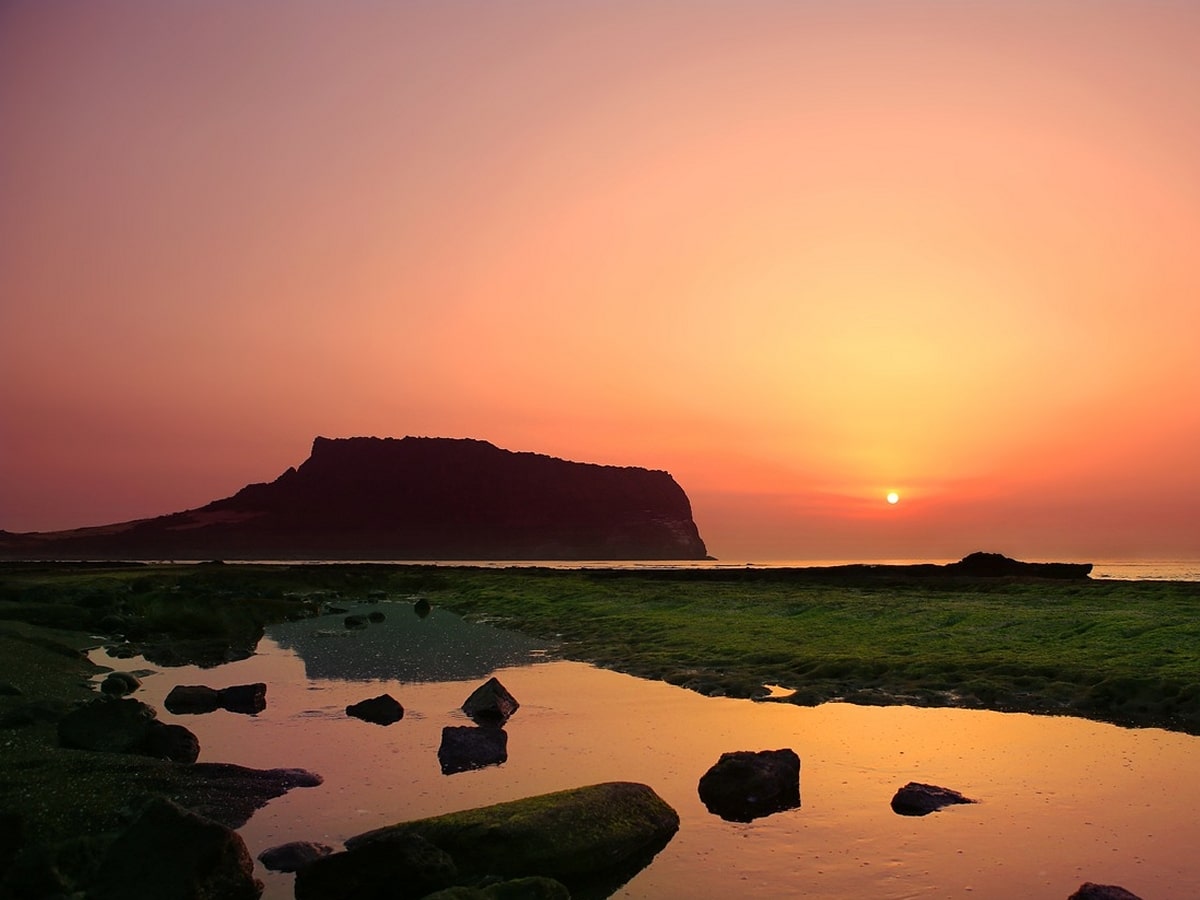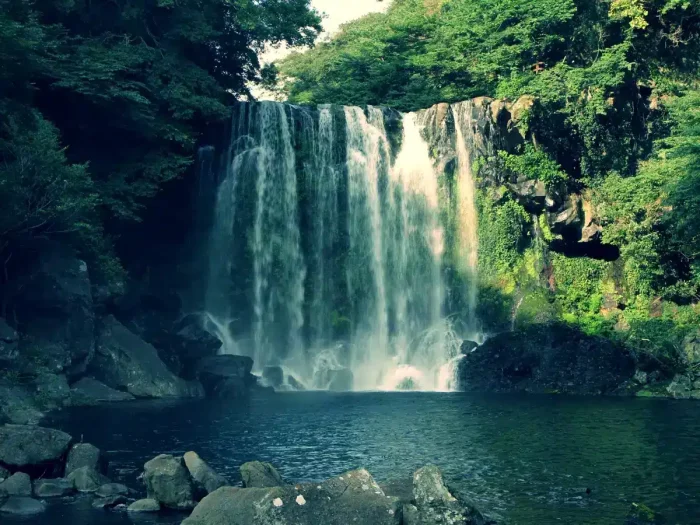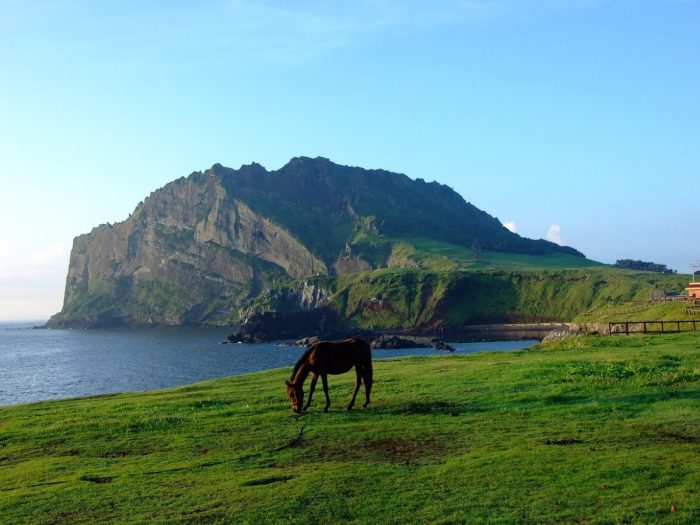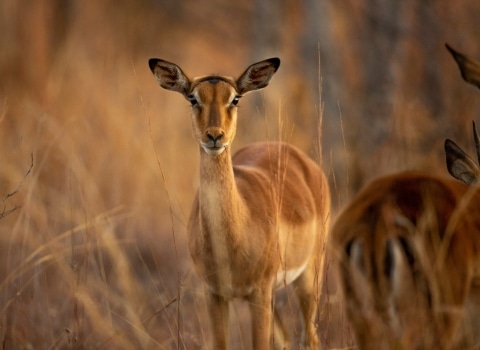Why Jeju Island Feels Like Another World
For anyone looking to step away from the noise and unpack somewhere between volcanic ground and quiet ease, South Korea holds a surprise offshore — Jeju Island. It’s not just another destination, more like a small world unto itself. The kind of place where you drift, almost without noticing, from a coastal path to an ancient lava flow, from a plate of fresh seafood to a hike through drifting fog. It’s both stripped-down and layered. And to start getting a feel for it, here are a few ways in.

1- Seongsan Ilchulbong, Jeju’s volcanic cone
There’s no missing that massive silhouette facing the sea. Seongsan Ilchulbong rises gently to 182 meters — formed by a coastal eruption around 5,000 years ago. Now a UNESCO World Heritage site, this quiet crater draws early risers hoping to catch the sunrise up close. The ascent is easy, maybe half an hour. At the top, a rim lined in green. And all around, just sea. No real noise, only wind and shifting light.
2- Going to Udo Island
A short ferry ride — and it feels like a different place altogether. Udo, Jeju’s smaller sibling to the east, spreads out like a cow lying down. That’s where the name comes from. People get around by bike, scooter, or a rattling old bus. The beaches shift between pale and volcanic black sand. There’s seafood to eat, water to walk beside, and the option of kayaking or snorkeling if the mood strikes. Nothing showy. But nothing’s off. And that’s enough.
3- The haenyeo culture, Jeju’s female divers
This might be what lingers most. A handful of women — often older — dive without tanks, without fuss, gathering shellfish and seaweed from the seabed. The haenyeo are something else. A living thread, passed down from mother to daughter. Their quiet strength, their deep knowledge — it’s all still here, holding on. You can watch them work from the shore. Or step into the small museum that tells their story. Better still, taste what they bring back — in a modest little spot by the sea. The ocean, on a plate.
4- Beaches and relaxation in Jeju island
If all you want is to slow down — towel out, sea air on your skin — Jeju delivers. Hyeopjae offers clear water and pale sand. Hamdeok is livelier, with families, teens, people meeting up. Then there’s Jungmun — made for movement, surf, spray. The coast is open, the light always shifting. And if the day stretches out, there are warm baths, quiet guesthouses, cafés that catch the horizon. There’s a kind of ease here. The kind you feel in your body.
5- Jeju’s waterfalls

On Jeju Island, some waterfalls seem to fall straight from the sky. Tucked into green, half-hidden, they appear as the path turns or along the shore. One stands out — Jeongbang. The only one in Asia that drops directly into the sea. You hear it, feel the salt in the wind, watch the foam. And stay there, not quite knowing why. Inland, Cheonjiyeon — “sky pond” — feels softer, quiet. Nearby, the three falls of Cheonjeyeon follow each other like slow breathing — rock, moss, a fine mist in between.
6- Tea plantations
Where the island’s black volcanic soil meets the soft sea breeze, tea takes root. Around Hallasan, the fields of Jeju stretch out in quiet terraces, neatly traced. Walking between the rows feels almost meditative. The tea here follows its own rhythm, carries its own memory. In nearby cafés, cups steam slowly. O’sulloc’s green tea — cultivated since the late 1970s — is found everywhere now. But something shifts when it’s sipped here, with dirt underfoot and a heavy sky above. No need to explain it. Just taste.
7- Manjanggul cave
Beneath the island’s calm surface lies something else. Cold, dark, silent. Manjanggul Cave isn’t just a geological quirk — it’s one of the longest lava tubes ever found. Over thirteen kilometers, though only a short stretch is open to explore. An hour of walking through shadow, tracing basalt walls and the frozen forms of a prehistoric eruption. There, a vast tunnel, carved out by molten rock. Here, a lava column, rising like a cathedral. The floor is slick. The air damp. And the silence… complete. You come out changed, if only slightly.
8- Hallasan National Park, South Korea’s highest peak

At the center of Jeju stands a volcano. Quiet. Immense. Hallasan. Peaking at 1,950 meters, it’s the tallest mountain in South Korea. But it’s more than elevation — it’s a whole world of thick forests, mossy ground, and shifting wind. The national park that surrounds it shelters rare species, delicate ecosystems, strange and beautiful things. Trails wind up its slopes and ridges, some reaching the summit. The Seongpanak route is the most walked, rising gradually. Four hours, give or take. At the top: a crater lake. And around it — the island, laid out like a living map.
9- Visit one or more Buddhist temples
Between stones, trees, and birdcalls, sometimes a roof appears. A hanging gong. A paper lantern left behind. Jeju’s temples don’t announce themselves. They wait. Yakcheonsa is vast, almost overwhelming, with halls filled with golden figures. Sanbangsa hides in a cave at the foot of Mount Sanbangsan. The climb is steep. At the top, Buddha faces the sea. People linger. The wind moves through. Silence thickens. And time slows down.
10- Jeju Olle, the long hike around the island
Walk. Just that. Along the coast, past fields, beneath pine canopies. The Jeju Olle is a looping trail, circling the island in 26 segments — each like a scrap of a larger story. Every section spans 10 to 20 kilometers. Some do one. Others string them together. Villages, beaches, volcanic hills pass by. Sleep happens where it can. Conversation is rare. And somewhere in the rhythm of steps, something settles. A kind of stillness. Or simply the feeling of truly being where you are.
11- Seongeupl folk village
Black stone walls. Thatched roofs. Wooden gates. Seongeup Village isn’t a museum piece — it’s lived in. People walk between jeongnangchae houses, built with island lava. Traces of another time linger. The fortress. The shrine. The scholar Yi Eok-gi’s home. Each tells part of a story — not a grand tale, but glimpses of life, belief, defiance. The village is easy to reach from Jeju island, by bus or car. No entry fee. One hour, maybe two. You look around, listen a bit. And sometimes stay longer than planned, for no particular reason.




